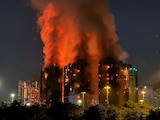- Failure to implement integrated early warning system worsens Uttarkashi flood impact
- Experts call for AI-based nowcasting and mobile alerts to predict cloudbursts with lead time
- Unplanned development and river encroachments amplify flood damage in Uttarkashi and Dharali
As the devastating flash floods in Uttarkashi claim lives and livelihoods yet again, experts flagged the failure to implement an integrated early warning system for the Himalayan region. The plan has been discussed for long and the experts warned that blaming climate change for such tragedies masks systemic governance failures.
This, they say, is worsening the inherent vulnerabilities in areas like Uttarkashi and high-altitude villages such as Dharali.
Calling for urgent action, they demand independent assessments to uncover the root causes of such tragedies and insist on accountability.
Former Secretary of the Ministry of Earth Sciences Dr Rajeevan reflected on past efforts to address such vulnerabilities.
"When I was the Secretary, we discussed an integrated early warning system for the whole Himalayan region. It was recorded in a high level meeting but it was not implemented," he said. "We need such a resilient system for the Himalayan region. The Ministry of Earth Sciences has recently launched the Mausam Mission. They should attempt to develop such early warning systems under that mission.
The government has provided adequate funds to them. I understand the MoES will be taking up such initiatives. Yes, it should be implemented urgently. Otherwise, more damages can happen."
Strengthening Early Warning Systems
To improve Uttarakhand's Early Warning Systems for cloudburst-induced flash floods, experts advocate a multi-pronged approach leveraging advanced technology and community engagement.
Dr Rajeevan emphasised upgrading observational infrastructure, including a dense network of X-band radars in upstream river catchments, more automatic weather stations, rain gauges, and river and stream gauging stations.
"We need very high-resolution weather prediction models, about 1-3 km resolution," he said, acknowledging their limitations. "The accuracy of such physical models is not that good. Therefore, Artificial Intelligence-based algorithms should be considered," he added.
He proposed developing AI-driven nowcasting systems that integrate satellite imagery, lightning data, and radar inputs to predict cloudburst events with a 1-3 hour lead time, coupled with mobile alert systems for rapid dissemination.
Additionally, localized flash flood guidance systems using terrain-specific hydrological models and community-centric warning systems at the panchayat level were highlighted as critical.
"Mobile and app-based alerts, along with terrain-specific hazard zoning and land-use policies, are essential to minimize risks," Dr Rajeevan added.
Himanshu Thakkar of the South Asia Network on Dams, Rivers & People, echoed the need for technological advancements but stressed the importance of effective disaster management systems to act on early warnings.
"This will be a combination of Doppler radars, satellite monitoring, river-based ground monitoring, and more intense monitoring in identified vulnerable locations," he said.
"More importantly, we need a disaster management system that can use such advance information to remove people in time from vulnerable locations. We have a long way to go on this," he added.
Mr Thakkar also called for robust governance mechanisms, including "honest, credible environment and social impact assessments of all major interventions, independent appraisals, confidence-inspiring monitoring, and compliance systems" to ensure accountability. "We are pretty poor in all these aspects," he noted.
Unplanned Development Amplifies Disaster Impact
The flash floods in Uttarkashi, particularly in areas like Dharali, were exacerbated by unplanned development, including the proliferation of hotels and homestays encroaching on river paths. Mr Thakkar highlighted the absence of policies to regulate such constructions.
"We have no system to ensure that hotels, homestays, and other civil constructions are not encroaching on the path of rivers and streams. There is no system to remove such encroachments, and no assessment of the amount of space a river needs considering the current rainfall pattern and catchment health," he said.
He pointed out that major projects like dams, hydropower plants, highways, railways, and urban centers contribute to environmental degradation by dumping muck into rivers, while schemes like riverfront developments and floodplain encroachments further constrict waterways.
"The health of our catchments is degrading, which means rainfall is quickly converting into flow. That, combined with intensification of rainfall, means rivers need greater waterway, not smaller," Mr Thakkar explained.
Dr Rajeevan also stressed the need for regulatory reforms, urging stricter controls on construction and tourism.
"They are really spoiling the environment and river flow," he said, advocating terrain-specific hazard zoning and land-use policies to balance tourism with ecological safety.
Integrated Flood Management for Resilience
With cloudbursts becoming more frequent in Uttarakhand, potentially linked to climate change, experts underscore the need for integrated flood management strategies to enhance resilience, especially in high-altitude villages like Dharali. Mr Thakkar emphasized a combination of early warning systems, policies ensuring sufficient river waterways based on current and projected rainfall patterns, and robust monitoring and disaster management systems. "Most importantly, we need independent assessments that will provide information for accountability mechanisms," he said, advocating for post-disaster independent reviews to learn lessons and fix accountability.
While acknowledging the role of climate change, Thakkar cautioned against using it as an excuse for poor governance. "The science of attribution is still being developed and today is not good enough to provide direct attribution. But climate change science tells us that in every such event of intensification of rainfall, there is a footprint of climate change," he said.
"However, climate change should not be used as a carpet under which we can push all kinds of accountability and misgovernance. We know these events are increasingly likely, and we better be prepared for them rather than blaming it on climate change."
Dr Rajeevan similarly called for proactive measures under the Mausam Mission, urging the Ministry of Earth Sciences to prioritise early warning systems. "The government has provided adequate funds. It should be implemented urgently," he reiterated.















